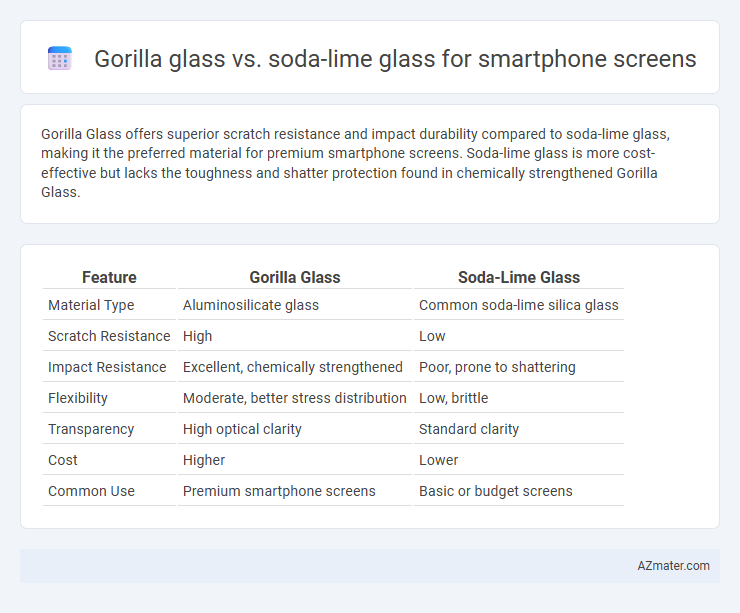Gorilla Glass offers superior scratch resistance and impact durability compared to soda-lime glass, making it the preferred material for premium smartphone screens. Soda-lime glass is more cost-effective but lacks the toughness and shatter protection found in chemically strengthened Gorilla Glass.
Table of Comparison
| Feature | Gorilla Glass | Soda-Lime Glass |
|---|---|---|
| Material Type | Aluminosilicate glass | Common soda-lime silica glass |
| Scratch Resistance | High | Low |
| Impact Resistance | Excellent, chemically strengthened | Poor, prone to shattering |
| Flexibility | Moderate, better stress distribution | Low, brittle |
| Transparency | High optical clarity | Standard clarity |
| Cost | Higher | Lower |
| Common Use | Premium smartphone screens | Basic or budget screens |
Introduction to Smartphone Screen Materials
Gorilla Glass and soda-lime glass are two primary materials used in smartphone screen manufacturing, each offering distinct advantages in durability and cost. Gorilla Glass, a chemically strengthened aluminosilicate glass developed by Corning, provides enhanced scratch resistance and impact durability, making it ideal for high-end smartphones. Soda-lime glass, commonly used in budget devices, is more affordable but lacks the robust protective qualities of Gorilla Glass, leading to a higher risk of damage under daily wear and tear.
What is Gorilla Glass?
Gorilla Glass is a brand of chemically strengthened glass developed by Corning, designed to provide enhanced scratch resistance and durability for smartphone screens. Unlike soda-lime glass, which is the standard glass composition made primarily of sodium oxide and lime, Gorilla Glass undergoes an ion-exchange process that replaces smaller ions with larger ones to create a compressed surface layer, increasing its toughness. This advanced manufacturing makes Gorilla Glass significantly more resistant to damage from drops and everyday wear compared to traditional soda-lime glass.
What is Soda-Lime Glass?
Soda-lime glass, composed primarily of silica (about 70-75%), sodium oxide, and calcium oxide, is the most common and cost-effective glass used in various applications, including basic smartphone screens. It offers moderate hardness and scratch resistance but lacks the enhanced durability and impact resistance found in Gorilla Glass, which is chemically strengthened through an ion-exchange process. Comparing the two, Gorilla Glass provides superior protection against drops and scratches, making it the preferred choice for premium smartphones.
Durability and Scratch Resistance Comparison
Gorilla Glass outperforms soda-lime glass in durability and scratch resistance due to its chemically strengthened aluminosilicate composition, which enhances impact resistance and reduces surface damage. Soda-lime glass, commonly used in budget smartphones, lacks the same level of toughness and is more prone to scratches and cracks under everyday use. The advanced compression layer in Gorilla Glass significantly extends the lifespan of smartphone screens by maintaining structural integrity against drops and abrasions.
Impact and Drop Protection
Gorilla Glass offers superior impact resistance and drop protection for smartphone screens compared to soda-lime glass due to its chemically strengthened aluminosilicate composition. Its ion-exchange process enhances surface hardness, significantly reducing the likelihood of cracks and scratches from everyday drops. In contrast, soda-lime glass, commonly used in standard applications, lacks this reinforcement and is more prone to shattering upon impact.
Clarity and Touch Sensitivity
Gorilla Glass offers superior clarity with high light transmittance and minimal distortion, enhancing the visual experience on smartphone screens compared to soda-lime glass. Its chemically strengthened surface improves touch sensitivity, providing faster and more accurate response to user inputs. In contrast, soda-lime glass generally exhibits lower optical performance and reduced touch responsiveness, making Gorilla Glass the preferred choice for high-end mobile devices.
Thickness and Weight Differences
Gorilla Glass typically ranges from 0.4 to 1.2 mm in thickness, offering superior durability while maintaining a lightweight profile compared to traditional soda-lime glass, which is usually thicker and heavier. The thinner design of Gorilla Glass enhances smartphone sleekness and reduces overall device weight without compromising impact resistance. Soda-lime glass's greater thickness contributes to increased weight, making it less ideal for modern smartphones demanding slimness and lightweight construction.
Cost and Manufacturing Considerations
Gorilla Glass, composed of alkali-aluminosilicate, offers superior scratch resistance and durability compared to soda-lime glass, but its production involves higher costs due to specialized chemical strengthening and controlled manufacturing environments. Soda-lime glass, being less expensive and widely available, is favored for budget smartphones and devices where cost-efficiency outweighs the need for enhanced toughness. The trade-off between manufacturing expenses and performance durability drives manufacturers to choose Gorilla Glass for premium models and soda-lime glass for cost-sensitive applications.
Environmental Impact and Sustainability
Gorilla Glass, made from alkali-aluminosilicate, exhibits higher durability and scratch resistance, reducing the frequency of smartphone screen replacements and thereby minimizing electronic waste. Soda-lime glass, the most common and less durable form, is cheaper but often leads to quicker screen damage and higher waste generation. Manufacturing Gorilla Glass demands more energy and specialized raw materials, yet its extended lifespan supports sustainability by lowering resource consumption over time.
Which Glass is Better for Smartphones?
Gorilla Glass offers superior scratch resistance, higher durability, and enhanced impact protection compared to soda-lime glass, making it better suited for smartphones. Soda-lime glass is more prone to scratches and breakage due to its lower hardness and impact resistance. The advanced chemical strengthening of Gorilla Glass provides a longer-lasting, more resilient screen that improves smartphone longevity and user experience.

Infographic: Gorilla glass vs Soda-lime glass for Smartphone screen
 azmater.com
azmater.com